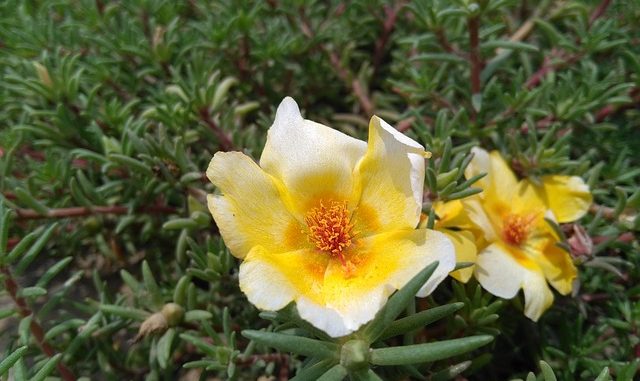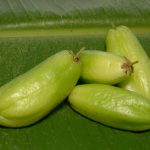
Portulaca oleracea L. (Family: Portulacaceae) or its more common name, Purslane is a widespread medicinal plant that is used as an edible plant too. It is also a traditional medicine for alleviating a wide spectrum of diseases.
Growth And Habitat
The plant which originally came from Asia is now widely grown as a salad crop. Most growers consider it ideal for dry stony soils and does not like wet conditions. It is an annual and a herbaceous succulent.
The plant has potential in the recovery of salty soils because of its high halotolerance. The sub-species called subsp. sativa (Haw.) Celak. (a cultivar) is a more prominent member and worth considering as a vegetable plant for extensive cultivation.
Health Benefits Of Portulaca
The plant was mentioned by Dioscorides (40–90 CE), with the name of “andrachne”. It is a well-known plant in the European Traditional Medicine and has a long association with folk medicine.
P. oleracea was first discussed for extending life in an old monograph on medicinal plants called the De Materia Medica. Here it was used as an astringent, and a remedy for headaches, inflammation of the eyes and other organs, burning of the stomach, erysipela, disorders of the bladder, numbness of the teeth, excessive sexual desire, burning fevers, worms, dysentery, hemorrhoids, eruptions of blood, and bites (Lee et al., 2012; Iranshady et al., 2017).
In more general terms its pharmacological properties have been extended to reducing the risks of cancers, to protecting the liver, as a neuroprotector and general antioxidant.
In Chinese medicine it is called a “vegetable for long life” because of its association with promoting longevity. In the Chinese culture, the use of purslane has been extensively pursued for millennia but it is not clear when its use began. There is an extensive examination of its properties which is worth reading as a starting point on the uses and benefits of the plant (Zhou et al., 2015).
Phytochemical investigations show this plant has a wide range of secondary metabolites including alkaloids, terpenoids, coumarins, polysaccharides, flavonoids and organic acids. The plant also contains plenty of vitamin A and vitamin C (Sicari et al., 2018).
A number of flavonoids or homoisoflavanones were isolated as oleracones which have radical scavenging behaviour (Yang et al., 2018b). Soyalakaloid A has also been isolated (Xiu et al., 2018).
The most important pharmacological activities are renoprotective activities (i.e. protect the kidney) and various effects on metabolism.
P. oleracea extracts could successfully decrease blood glucose and lipid profiles of patients with metabolic syndrome. The pharmacokinetics of oleracone C mentioned earlier have been assessed in mice (Yang et al., 2018a) using the sensitive assay methods of UHPLC-ESI-Q-TOF/MS.
A 10% ethanolic extract of the aerial parts such as the dried leaves and stem has significant anti-inflammatory and analgesic properties (Chan et al., 2000). Similar alcoholic extracts exhibit strong antioxidant activity by mopping up free-radical compounds (Sicari et al., 2018).
The polysaccharides are strong antioxidants in their own right and were shown in rat studies to modulate immunity in those animals with ovarian cancer (Chen et al., 2009).
The juice of purslane was shown in animal studies to have a portent neuroprotective effect by reducing apoptosis of nerve cells (neurones), depletion of dopamine metabolites, and inhibition of complex‐І in the striatum of rats induced by rotenone (Moneim, 2013).
One of the most interesting activities is the protective effects of aqueous extracts which protect heart mitochondria in aging mice models (Ou et al., 2007).
The safety of P. oleracea has been reported in many clinical trials.
The seeds of the plant yield a valuable oil which is rich in linoleic, alfa linolenic and oleic acids. The seeds also contain alkylresorcinols (Gunec et al., 2019). The seeds have been shown to reduce menstrual bleeding in conjunction with the drug mefenamic acid in a randomized double-blinded placebo-controlled clinical trial (Mirzaei et al., 2018).
Conclusion
Modern pharmacological studies have now proven many traditional uses of P. oleracea, including anti-hyperglycemic and anti-hyperlipidemic, renoprotective and hepatoprotective effects. In addition, in many clinical trials P. oleracea showed no adverse effects and constipation was reported as the most frequent adverse effect.
References
Chan, K., Islam, M.W., kamil, M., Radhakrishnan, R., Zakaria, M.N.N., Habibullah, M., Attas, A. (2000) The analgesic and anti-inflammatory effects of Portulaca oleracea L. subsp. sativa (Haw.) Celak. J. Ethnopharmacology 73(3) pp. 445-451 (Article)
, , & (2009). Evaluation of free radicals scavenging and immunity‐modulatory activities of Purslane polysaccharides. International Journal of Biological Macromolecules, 45(5), pp. 448–452 (Article).
Gunec, A., Rowland, O., Xu, H., Marangoni, A., Hosseinian, F. (2019) Portulaca oleracea seeds as a novel source of alkylresorcinols and its phenolic profiles during germination. LWT 101 March pp. 246-250 (Article)
Iranshahy, M., Javadi, B., Iranshahi, M., Jahanbakhhsh, S.P., Mahyari, S., Hassani, F.V., Karimi, G. (2017) A review of traditional uses, phytochemistry and pharmacology of Portulaca oleracea L. J. Ethnopharmacology. 205 June pp. 158-172 (Article)
, , , , & (2012). Anti‐TNF‐α activity of Portulaca oleracea in vascular endothelial cells. International Journal of Molecular Sciences, 13(5), pp. 5628–5644 (Article).
Mirzaei, N., Moghaddam, F.S., Ozgoli, G., Sahranavard, S., Ghasemi, E. (2018) Purslane (Portulaca oleracea) effect on heavy menstrual bleeding (menorrhagia) in Iranian women. Adv Integrative Med. 5(2) pp. 56-62 (Article)
, , , , & (2018). Portulaca oleracea L. (Purslane) extracts display antioxidant and hypoglycaemic effects. Journal of Applied Botany and Food Quality, 91, pp. 39–46 (Article).
Xiu, F., Ying, Z., Ying, X., Yang, G. (2018) Pharmacokinetic studies of soyalkaloid A from Portulaca oleracea L. using ultra high‐performance liquid chromatography electrospray ionization quadrupole–time of flight mass spectrometry and its antioxidant activity. Biomedical Chromatography https://doi.org/10.1002/bmc.4399
Yang, X., Ying, Z., Ying, X., Yang, G. (2018a) A pharmacokinetic study on oleracone C after oral and intravenous administration. Fitoterapia 131 November pp. 44-49 (Article)
Yang, X., Zhang, W., Ying, X., Stien, D. (2018b) New flavonoids from Portulaca oleracea L. and their activities. Fitoterapia 127 (June) pp. 257-262 (Article) https://doi.org/10.1016/j.fitote.2018.02.032
, , , , , & (2015). Portulaca oleracea L.: A review of phytochemistry and pharmacological effects. Journal of Biomedicine and Biotechnology, 2015(5), 925631. (Article)

Really interesting item about purslane. I’ve been growing it for years in our rather dry garden and to know it has health benefits makes it more fascinating than it really is.